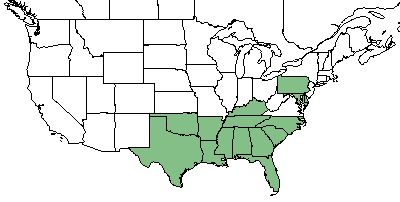Rhododendron canescens
Common names: pink azalea; southern pinxterbloom; Piedmont azalea; bush honeysuckle; hoary azalea; mountain azalea
| Rhododendron canescens | |
|---|---|

| |
| Photo by John Gwaltney hosted at Southeastern Flora.com | |
| Scientific classification | |
| Kingdom: | Plantae |
| Division: | Magnoliophyta - Flowering plants |
| Class: | Magnoliopsida - Dicots |
| Order: | Ericales |
| Family: | Ericaceae |
| Genus: | Rhododendron |
| Species: | R. canescens |
| Binomial name | |
| Rhododendron canescens Michx. | |

| |
| Natural range of Rhododendron canescens from USDA NRCS Plants Database. | |
Contents
Taxonomic Notes
Synonyms: Rhododendron canescens var. canescens, Rhododendron canescens var. candidum (Small) Rehder, Rhododendron canescens var. subglabrum Rehder
Varieties: Azalea candida Small, and Azalea canescens Michaux.
Description
R. canescens, also known as piedmont azalea and wild azalea[1], is a perennial shrub of the Ericaceae family native to North America.[2] It is a shrub that reaches a height of 5 meters tall, with 5 stamens that are approximately 3 times longer than the corolla tubes.[3]
Distribution
R. canescens is found in the southeastern corner of the United States from Texas to Pennsylvania with the exception of Virginia and West Virginia. [2]
Ecology
Habitat
R. canescens proliferates in swamps, pocosins, and savannas. [1] It has been observed in various habitats including sandy loam in mesic woods, magnolia-beech ravines, pine flatwoods, shrubs of bayheads, bottomland woodlands, deciduous wooded bluffs, wet streamsides, bank on shores, under shade of various hardwood forests, swampy woodlands, and near border of sand dune community. [4] R. canescens responds negatively to soil disturbance by clearcutting and chopping in North Florida flatwoods forests.[5]
Phenology
R. canescens has been observed to flower February through April [6], as well as in May, June, and November. Fruit development has been observed in February, March, April, June, and September. [4]
Fire ecology
R. canescens is not fire resistant and has low fire tolerance. [2]
Conservation and Management
R. canescens is listed as commercially exploited by the Florida Department of Agriculture & Consumer Services Division of Plant Industry, and as endangered by the Kentucky State Nature Preserves Commission. [2]
Cultivation and restoration
Photo Gallery
References and notes
- ↑ 1.0 1.1 Weakley, A. S. (2015). Flora of the Southern and Mid-Atlantic States. Chapel Hill, NC, University of North Carolina Herbarium.
- ↑ 2.0 2.1 2.2 2.3 USDA Plant Database https://plants.usda.gov/core/profile?symbol=RHCA7
- ↑ Coile, N. C. (2000). Notes on Florida �s Regulated Plant Index (Rule 5B-40), Botany Contribution No. 38, 3nd edition. Gainesville, Florida, Florida Deaprtment of Agriculture and Consumer Services, Division of Plant Industry.
- ↑ 4.0 4.1 Florida State University Robert K. Godfrey Herbarium database. URL: http://herbarium.bio.fsu.edu. Last accessed: June 2018. Collectors: Loran C. Anderson, Floyd Griffith, G. Gil, D. S. Kline, Sidney McDaniel, John B. Nelson, R. Kral, R. K. Godfrey, S. R. Harrison, R. E. Shanks, H. R. DeSelm, J. B. Nelson, R. H. Wnek, C. Anrrich, A. Anrrich, J. P. Gillespie, D. B. Ward, S. S. Ward, S. R. Harrison, Kathy Craddock Burks, Melanie R. Darst, E. S. Ford, John C. Ogden, Angus Gholson, Mark A. Garland, Robert L. Lazor, R. A. Norris, R. Komarek, Cecil R. Slaughter, J. Lorenz, S. B. Jones, Carleen Jones, James D. Ray, Jr., W. W. Ashe, P. Greear, W. C. Coker, H. R. Totten, T. G. Harbison, T. E. Smith, D. S. Correll, Helen B. Correll, Delzie Demaree, C. Jackson, Samuel B. Jones, Jr., John W. Thieret, Roomie Wilson, Raymond Athey, William Reese, and Joyce Romanus. States and counties: Florida: Jackson, Putnam, Wakulla, Hamilton, Leon, Bay, Walton, Libertym Washington, Okaloosa, Jefferson, Franklin, Columbia, Gadsden, Calhoun, Escambia, Holmes, and Clay. Alabama: Barbour, Geneva, Jefferson, Dallas, Jefferson, Mobile, Monroe, Covington, Clarke, Dale, Greene, Pickens, Limestone, Washington, and De Kalib. Georgia: Thomas, Floyd, Upson, Turner, Clarke, and Grady. Mississippi: Kemper, Lamar, Pearl River, Winston, Lauderdale, Harrison, Forrest, Webster, and Itawamba. Texas: Sabine. South Carolina: Lee, Orangeburg, and Dorchester. Arkansas: Bradley. Louisiana: Ouachita, Tangipahoa, Beauregard, Grant, Rapides, Jackson, De Soto, and Allen. Tennessee: Coffee, Bledsoe, and Lawrence. Kentucky: Calloway.
- ↑ Moore, W.H., B.F. Swindel, and W.S. Terry. (1982). Vegetative Response to Clearcutting and Chopping in a North Florida Flatwoods Forest. Journal of Range Management 35(2):214-218.
- ↑ Nelson, G. PanFlora: Plant data for the eastern United States with emphasis on the Southeastern Coastal Plains, Florida, and the Florida Panhandle. www.gilnelson.com/PanFlora/ Accessed: 30 MAY 2018